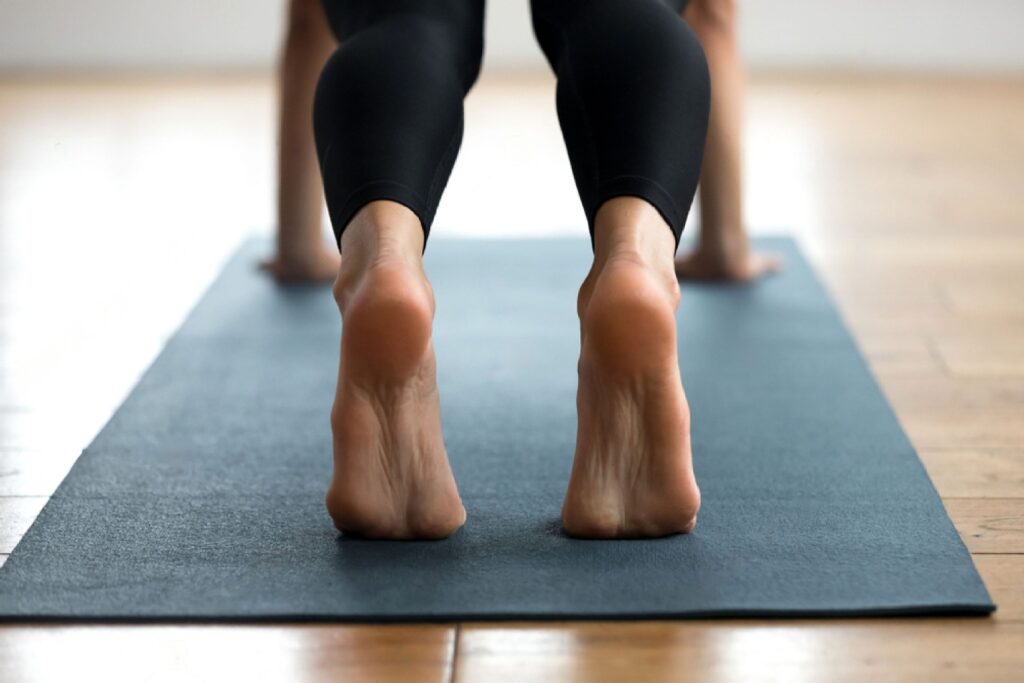Foot Push-Up Test to determine how your arches perform
How Are Your Arches? Take this simple test to check how well your arches are performing their important functions.
- In bare feet, stand facing a kitchen counter.
- Place your palms on the counter with slight pressure.
- Stand with your back straight, and lift one foot off the floor.
- Slowly lift the heel of other foot, placing all of your weight onto the ball of your foot.
- Slowly lower your heel back to the floor.
- Do 10 foot push-ups.
Repeat steps 1 – 6 with the other foot.
And now the results…
Did you have problems doing just one push-up?
If you cannot rise up onto the ball of your foot without putting lots of pressure on your hands, leaning over the counter or experiencing pain, your arch may have a mechanical problem. The arch tendon can stretch or rupture, leading to lowering of the arch. A foot and ankle surgeon should be consulted as soon as possible.
Were you able to do all 10 without a problem?
If you can easily rise up onto the ball of your foot, but have difficulty performing all 10 repetitions, you may be suffering from arch fatigue. Exercises focusing on strengthening and stretching leg muscles will help this problem. The foot push-up described above can also be used as an exercise technique.
Did you have pain in your arch during the exercise?
If you can easily rise up onto the ball of your foot but experience pain in your arch, your arch may be inflamed and may have been overworked. Consulting a foot and ankle surgeon for weak and overworked arches is recommended to manage the problem and keep your feet healthy and free of pain.
http://www.foothealthfacts.org/Content.aspx?id=1465
MORE ABOUT ARCHES
What are the Arches of the Foot?
The foot arches are formed by the bones, ligaments and tendons of the foot and are essential for both movement and weight bearing. The shape and height of your foot arches are unique; no two people are the same.
The human foot is an incredibly complex mechanism that has two very important functions:
- Weight bearing
- Propulsion in walking, running and jumping.
To perform these functions, the foot requires a high degree of stability as well as flexibility.
The multiple bones and joints of the foot give it the necessary flexibility, but to fully support any weight, the bones of the foot need to form an arch.
The Three Arches of the Foot
The foot has three distinct arches. Two longitudinal arches (one on each side) run from front to back; one transverse arch runs across the midfoot from inside to outside.
Medial Longitudinal Arch
The medial longitudinal arch is the most prominent foot arch and what is typically referred to as simply, “the arch.” It runs from front to back along the inside of the foot. This arch absorbs the majority of the shock of impact while walking, jumping or running.
Lateral Longitudinal Arch
The lateral longitudinal arch runs parallel to the medial longitudinal arch but is along the outer edge of the foot. The lateral longitudinal arch is most visible in people with very high arches.
Transverse Arch
The final foot arch is called the transverse arch.
It runs across the midfoot from outside to inside. This arch also provides support and flexibility to the foot.
The arches of the foot are maintained not only by the shapes of the bones as well as by ligaments. Also, muscles and tendons play an important role in supporting the arches.
Foot Types
The arches, along with the other tissues of the foot, help determine a person’s foot type.
High Arches
A high arch is also called pes cavus or cavus foot. As the height of each person’s arches varies normally, it may not be a problem. They can be hereditary. A high arch can be more prone to overuse injuries when you play sports or run. High arches do not absorb shock as well or provide as much support while walking. You may benefit from cushioned shoes and custom molded shoe inserts to help with shock absorption
Flat Feet and Fallen Arches
Babies and children often appear to have flat feet because they have fat pads on the sole of their feet. They usually develop a more distinct arch. Adults can have flexible flat foot or can acquire a flat foot deformity when the posterior tibial tendon becomes weak, which is often called fallen arches. (The posterior tibial tendon runs behind the inside bump on the ankle (the medial malleolus), across the instep, and into the bottom of the foot. The tendon is important in supporting the arch of the foot and helps turn the foot inward during walking.) If flexible flatfoot is painful, custom shoe orthotics and stretching the Achilles tendon is often recommended. For adult-acquired flatfoot, the treatment may progress from custom shoe orthotics to a walking boot and physical therapy or even surgery.
Neutral Foot Type
If your foot or your footprint doesn’t look flat-footed or high-arched, you most likely have a neutral or normal foot. Your footprint will have a noticeable curve inward, but not by more than 3/4 of an inch.
https://www.verywell.com/foot-arches-form-and-function-3120348




